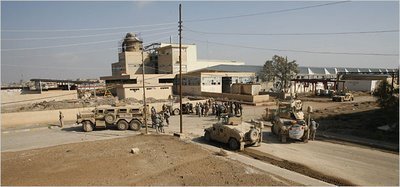"We have missed an opportunity to make people feel welcome," said Jay Rasulo, chairman of Walt Disney Parks and Resorts. "The whole process must be friendlier and more efficient. We must invest in creating a first impression of hospitality and friendliness at our borders."
 [Image: Disney World 2004.]
[Image: Disney World 2004.]Faced with a decline in the number of overseas visitors and unpopular entry requirements, the U.S. government is turning to the Walt Disney Co. and other theme park operators to brighten the country's battered image. -
Reuters.
Where Dreams Come True...?
Last October, we
read about the U.S. Coast Guard's plan to create 34 live-fire zones on the Great Lakes, in order to train personnel on machine guns that fire 600 lead bullets per minute. We were looking at dumping almost 11,000 pounds of lead per year into the world's largest supply of fresh water. However, after criticism, and hopefully coming to their sense, the Coast Guard recently
dropped their plan for a Great Lakes firing range playground.
We Must Prevent Permanent Bases in Iraq: Congress passed a law banning permanent bases in Iraq and the Baker-Hamilton Report suggests that Bush state we don't have long-term plans - meanwhile, construction continues.
In Baghdad, "The city's parks supervisor has made it
his mission to beautify the city even as continuing war destroys Baghdad's once opulent gardens.
"The flowers appear overnight, and in the unlikeliest of places: carnations near a checkpoint, roses behind razor wire, and gardenias in a square known for suicide bombings."
Defense Tech, covering the
Wall Street Journal, says, Military Going Green... But Still Chugging Oil.

Revive industries, create jobs, fight terrorism with socio-economic progress – wow, there’s a novel idea. Nevertheless, this is a great article and audio piece by James Glanz in the
NYT.

It is a strange landscape he says, the kind of industrial you only find in Iraq.
“Inside a huge shuttered factory on the gritty western fringes of this outlaw desert town, thousands of ornate porcelain sinks, toilets and other fixtures sit in row after row next to the automated ovens and assembly lines that once churned out the products but lie silent under a thin film of yellow desert dust.”
Insurgent TV Coming to a Satellite Near You? The Round City of the House of Wisdom
The Round City of the House of Wisdom, another view of Baghdad. And going
Door to Door in Sadr City.
In
500 Miles to Babylon, video activist David Martinez has captured the outrage and sufferings of civilian victims of the carnage in Iraq.
The Nation.
 Ellis Island: Ghosts of Freedom
Ellis Island: Ghosts of Freedom documents the weather-beaten remnants of the immigration hub's abandoned hospital buildings, where people who steamed past the Statue of Liberty on crowded ships were sometimes held back if they had an infectious disease or obvious disorder
 In South African prisons
In South African prisons.
 Mission Control
Mission Control Projected images designed to scare an enemy
Projected images designed to scare an enemy?
Nick Hawton follows a crazy crytogeographic path through Poland where "unusual planes arrived at the Szymany airport in 2003" allegedly as part of the CIA's secret gulag system camping on european runways.

Atomic tourism During the heart of the cold war, from the 1960s to the mid-80s, the 54 Titan II underground complexes like this one — with its blast doors, firing console and spartan crew quarters, all preserved as the Titan Missile Museum — were part of the American program of nuclear deterrence, on constant alert to keep aggressive impulses in the Soviet Union at bay. -
NYT.
Federal agencies are moving to relocate outside a 50-mile range from Washington DC outside the nuclear fallout zone. Read
here &
here.
Tracking illicit nuclear trade: "‘By using a cluster analysis algorithm coded into a program, I evaluated those traffic patterns and routes in which thefts, seizures, and destinations of materials were reported,’ said Sandia researcher David York. ’Data from these examinations were enough to allow me to retrospectively depict the A. Q. Kahn network before it was uncovered.’" (Sounds like something from the TV show
Numb3rs.)
Safety vs. Security In Restructuring Of Nation's Capital: Officials Argue Barriers Do Not Keep Residents Safe

Endless Prunings:
Google Guerrilla: "Terrorists attacking British bases in Basra are using aerial footage displayed by the Google Earth internet tool to pinpoint their attacks, say Army intelligence sources."
Cold War National Park: "Mildewed missile silos. Subterranean bunkers. Minefields and pestilential swamps. Silent airfields and cavernous airplane hangers. Barbed wires. Electric fences. Arcadian birch-covered hills. GPS navigators. World War III launch pads. Munition dumps. It's a landscape architect's paradise."
KGB Hotel: "So instead of a Presidential Suite with an ocean view, you'll be placed in solitary confinement or the interrogation room. Instead of pleasant greetings from a cheery staff, you'll be welcomed with gun fire and barking orders from (former) Soviet prison guards. And instead of signing the guestbook, you'll be processed, photographed, and given your arrest card."
The Army Corps of Engineers: The Game: "Remember the Sundarbans, that “tapestry of waterways, mudflats, and forested islands at the edge of the Bay of Bengal” and home to an unbelievably huge array of endangered species? The Independent reported last month that one of the inhabited islands there, Lohachara, has “disappeared beneath rising seas.”

And a BLDGBLOG.
Geology in the Age of the War on Terror: "A few months after September 11th, the New York Times published a kind of geological look at the War on Terror. In a short but amazingly interesting – albeit subscriber-only – article, the NYTimes explored how ancient landscape processes and tectonic events had led to the formation of interconnected mountain caves in which Osama bin Laden was, at that point, hiding."
[Earlier peripherals ...
1 2 3 4 5 6 7 8 9 10 11 12 13]











